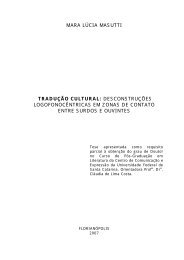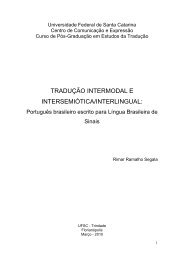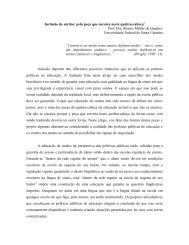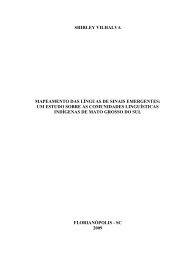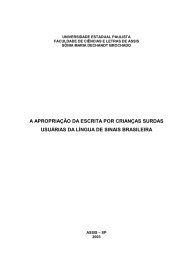Phrase Structure of Brazilian Sign Language - Ronice.cce.prof.ufsc.br
Phrase Structure of Brazilian Sign Language - Ronice.cce.prof.ufsc.br
Phrase Structure of Brazilian Sign Language - Ronice.cce.prof.ufsc.br
Create successful ePaper yourself
Turn your PDF publications into a flip-book with our unique Google optimized e-Paper software.
The proposal is based on the featural and affixal approaches<<strong>br</strong> />
developed by Lasnik (1995), and also on the morphological parameter proposed by<<strong>br</strong> />
Bobaljik (1995). I relate these analyses and present the phrase structures in LSB that<<strong>br</strong> />
account for the asymmetric behavior <strong>of</strong> the verbs. This approach is compatible with<<strong>br</strong> />
the minimalist program, since phrase structure is projected as a consequence <strong>of</strong> the<<strong>br</strong> />
interface motivations for meaning and sound/sign. Moreover, I state two general<<strong>br</strong> />
assumptions. First, all main sentences in LSB are tensed, as assumed by Aarons,<<strong>br</strong> />
Bahan, Kegl and Neidle – ABKN – (1995) for ASL, and therefore there is a<<strong>br</strong> />
functional projection for tense. There are some lexical items that are generated in this<<strong>br</strong> />
position, such as tense markers 13 . This assumption allows the subject to be basegenerated<<strong>br</strong> />
in Spec <strong>of</strong> T, then it will observe the EPP, since the subject position will<<strong>br</strong> />
be filled out, the second assumption made here (following Bobaljik, 1995). Bobaljik<<strong>br</strong> />
shows that there are enough reasons to assume Koizumi’s (1993) and Chomsky’s<<strong>br</strong> />
(1995) proposals that the subject must be generated outside <strong>of</strong> VP. He also observed,<<strong>br</strong> />
however, that there is no reason to stipulate the split <strong>of</strong> VP, as done by the original<<strong>br</strong> />
approaches.<<strong>br</strong> />
The basic idea put forward by Bobaljik (1995) is that some languages<<strong>br</strong> />
project agreement and tense, because there are agreement and tense features that<<strong>br</strong> />
must be checked during the derivation (Free-Agreement languages). Other languages<<strong>br</strong> />
solely project inflection for checking related to agreement or tense (Non-Free-<<strong>br</strong> />
Agreement languages). I suggest that there are also languages which can set both<<strong>br</strong> />
possibilities. This is caused by the existence <strong>of</strong> features related to both kinds <strong>of</strong><<strong>br</strong> />
information in different verbal classes. For instance, main verbs in English are<<strong>br</strong> />
affixal, and there is no Agr projection, whereas French verbs, have and be in English,<<strong>br</strong> />
and inflected verbs in LSB do present AgrP. The grammar has the two options<<strong>br</strong> />
available and one and/or the other will be set considering the features inserted with<<strong>br</strong> />
the lexical items during Numeration.<<strong>br</strong> />
One <strong>of</strong> the characteristics observed by Bobaljik for languages that do<<strong>br</strong> />
project agreement is that in these languages there is a target in the phrase structure<<strong>br</strong> />
for possible object-shift when the verb moves to a higher position overtly (observing<<strong>br</strong> />
Holmberg’s generalization, 1986).<<strong>br</strong> />
LSB, as well as ASL, allows object shift. Independent motivations for<<strong>br</strong> />
this movement have not been analyzed for LSB yet. As for ASL, Matsuoka (1998),<<strong>br</strong> />
Braze (ongoing) and Chen (ongoing) have provided some explanations. I give some<<strong>br</strong> />
examples to show that object-shift is a common syntactic operation in these<<strong>br</strong> />
languages.<<strong>br</strong> />
(41) ASL<<strong>br</strong> />
a) [AgrSP [AgrS’ [TP WOMAN [T’ [AgrOP PIE i [AgrO’ PUT-IN-OVENj [VP ti [V’ tj ]]]]]]]]<<strong>br</strong> />
The woman put the pie in the oven<<strong>br</strong> />
(42) LSB 14<<strong>br</strong> />
a) _________________eyegaze ______hn<<strong>br</strong> />
13<<strong>br</strong> />
This assumption must be investigated more deeply, since there is no morphological marker for<<strong>br</strong> />
tense attached to the verb.<<strong>br</strong> />
14<<strong>br</strong> />
In these LSB examples, I assume the V raises to AgrO. When the V moves, the object may move to<<strong>br</strong> />
Spec <strong>of</strong> AgrOP. This explains the word order SVO with agreement verbs including handling verbs.<<strong>br</strong> />
13



